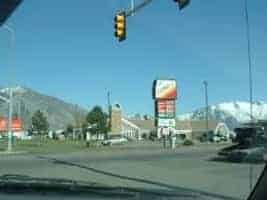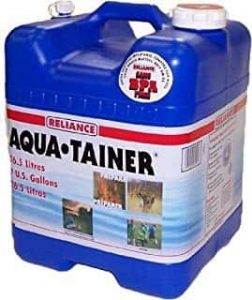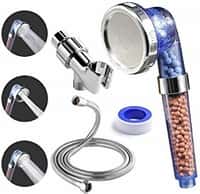Where To Get Water When Boondocking?
It is quite obvious that a steady water supply isn’t a luxury out in the boonies. Compared to a large number of campgrounds that have water filling stations or the like.
But regardless of the fact that there are no amenities (water supply included) being made available out in the boonies.
There are other reliable ways you could still get water while you are out boondocking.
So in this post, we will not only discuss ”where to access water” but also ”how to conserve and purify the same” for your own good.
Contents
Some Recommendations for a Water Supply:
Where to get water when boondocking? A good number of Recreational Vehicle ”dumps and dump sites” do have drinkable water apart from just private, public, dump stations scattered across the country.
You could also rely on the services of ”Pilot Flying J Travel Centers” in a bid to access not just water, but also, a restaurant. dump station, and a discounted rate on each container of gasoline you purchase.
But meanwhile, you’ll either have to download their application or get the reward card before you could access a three(3) cent discount on each gallon of gasoline.
Also, a couple of National Forests that are adjacent to National Parks do have dispersed campgrounds with pretty good communal water fill station.
More specifically, a ”water bandit” may be required at some point to – help hookup your hose to the no-threads faucets.
Additional Vital Information:
”Pilot Flying J Travel Centers” has been offering quality services to RV travelers and truckers for a good number of years.
It is also paramount to know that ”National Forests” ain’t as populated as ”National Parks.”
That also made ”getting campsites” pretty much easier.
Traveling to the ”National Park” with a tow vehicle (if available), could make ”leaving your dwelling unit” at the campsite a huge possibility.
You would also find journeying or perhaps touring and parking a lot easier.
Furthermore, you could also get water from a lot of other places. Like private campgrounds, truck stops, regional/county parks, highway restive areas, gas stations, and tourist welcome centers.
You could also go with five (5) gallon water containers in case you happen to eventually run out of drinking water.
Utilizing Water Jugs:
Undoubtedly, getting jugs for your boondocking adventure is perhaps the easiest method for addressing unavailability of water.
Interestingly, it is quite easy to transport jugs, refill them on time, as against the length of time it would take to fill up the RV (Recreational Vehicle).
Upon leaving the boonies where your RV is parked, the water jug could even sustain you for a trip to the town area.
You could also transfer water stored in jugs into an empty RV water container or tank.
Water contained in Jugs could also serve external purposes – (especially at washing stations for hand, hair, et cetera).
The Cost:
You could get a seven(7) gallon jug at a Wal-Mart for about $8 (USD) or thereabouts.
Yeah, it is pretty cheap and would greatly help to increase your water supply storage.
P.S – Know the number and capacity of water containers you would need, then do the math.
Note:
The water jugs could be placed either at the back section of your Jeep, resting the weight on the floor level of your bathroom.
Or perhaps they could be positioned at the interior of your RV until you get to your final destination.
P.S – You surely wouldn’t regret the increased water supply when you make efforts to know what’s suitable for your RV setup.
Conserving Your Water:
Even with the additional water jugs in place, you may also like to go a couple of weeks amidst water fill-ups whenever possible.
That being said, water conservation should be considered top priority amongst your other plans.
Going forward, let’s discuss conservation as it regards the following;
Dishes:
At some point, you may have utilized several ”methods for conserving water” in the course of boondocking.
Even so, one of such methods is the use of two dishpans or sink (though it depends on the rig type), to contain soapy and rinsing water.
You would also realize that the amount of water being utilized is quite fair.
It would be cool to also adopt the European style of taking a sponge, fill it with soap, scrub the dishes with the same, and then rinse with water beneath the faucet.
P.S – That could greatly help in conserving water when dishwashing.
Shower System:
Turning water ”on and off” all through the showering process is yet another pretty good European style for conserving water while having a shower.
That isn’t the case with a good number of Americans who consume much water as a result of leaving the system on while showering till the end.
Going forward, with the European method – you could have a shower by simply applying the underlying 1,2,3 formation.
- Turn on the water system, then rinse.
- Then turn off the water system, then scrub.
- Turn on the water system, then rinse again.
P.S – By so doing, you would definitely conserve more water for future use.
Note:
Make efforts to get a shut-off valve to help keep the water temperature at the exact level you’d like it to be.
With that in place, you can as well control the ”on and off” process with ease.
It is indeed a great device for water conservation.
Harnessing Natural Water Mediums:
One of the very best methods for conserving an appreciable amount of water is – taking advantage of natural sources (the likes of river, stream, lake).
Though it’s a different ball game when dealing with the dry desert areas.
However, it works fine for those boondocking couple of miles away from civilization.
That being said, you could leverage on water from lakes, rivers, and streams to shower, wash the dishes, et cetera.
But meanwhile, ensure you approach the same with medicated soaps, shampoos, and the likes of other preventive measures.
Note:
The feeling you get when you learn how to outsmart a very cold spring tucked deep down in the woods, could be quite exciting and fulfilling.
Regardless of how difficult it seems to delve into the water problem. If you would always appreciate your gut feeling (if you so do and eventually come out safe).
P.S – Undoubtedly, utilizing water from natural sources would ensure the water you’ve got stored in the RV – last much longer than expected.
As stated much earlier, you could also get a water jug to serve as a reservoir for later use.
The Campground Strategy:
This would make a lot of sense to RV travelers on a long trip or perhaps those who intend to live full time on the road.
Meanwhile, some individuals would barely want to spend the night in a campground.
It all depends on what you want.
However, a good number of campgrounds do have sewer dumping stations, and you could also refill your water tank plus jugs for just a few dollars.
Furthermore, a couple of campgrounds do also have some hot water showers at a pretty good rate.
Note:
It is okay to do your due diligence on prices, so you don’t end up paying much in an effort to spend the night in a campground.
In some cases, the service fee of a particular campground could be slightly higher than others without you knowing.
But meanwhile, if you discover the difference in service price isn’t that much or almost the same,
And you could get what you want, I suggest it isn’t a bad idea to spend the night there.
Purchasing Drinkable Water:
You could save a great deal of water to serve other things if you resort to buying the water you drink.
Also, keeping water in distinct, meager jugs, inside of your recreational vehicle – could also increase the chances of you having some clean, safe water to drink.
Sometimes, you could also refill the jugs, stock them up at any grocery store of your choice, and then make a new purchase.
Note:
Whenever you’re running short of water and you know it would be pretty difficult to refill for a while, just buy water you could drink to guaranty an extended supply.
Summary:
If you plan on boondocking (or perhaps dry camping) for a couple of days within a given season.
It is quite obvious the fresh water tank on your RV (Recreational Vehicle), camper, or trailer will eventually experience a shortage.
So, it could be very hectic to break camp in order to take your RV to go get some water.
That’s one reason a good number of RV travelers do resort to portable water jugs to serve their subsequent needs.
Note:
Mind you, some water containers could as weigh much as 50-70 pounds, making it quite tough to transport them.
However, try to find out the exact size that would suit your taste and chores.
Also make further inquiries on the services being rendered by Pilot, Flying J Travel Centers, and private campgrounds,
Truck stops, regional/county parks, highway restive areas, gas stations, and tourist welcome centers.
It would help to keep you up-to-date, so you don’t fall for anything fishy.


